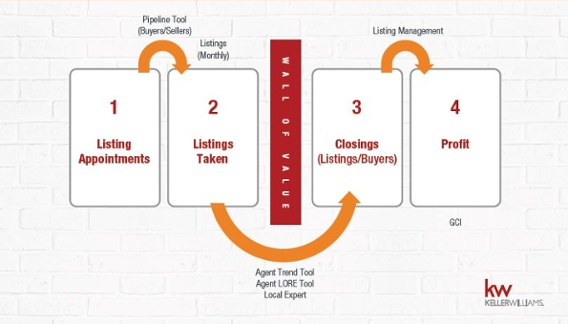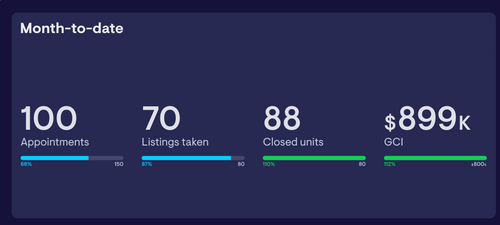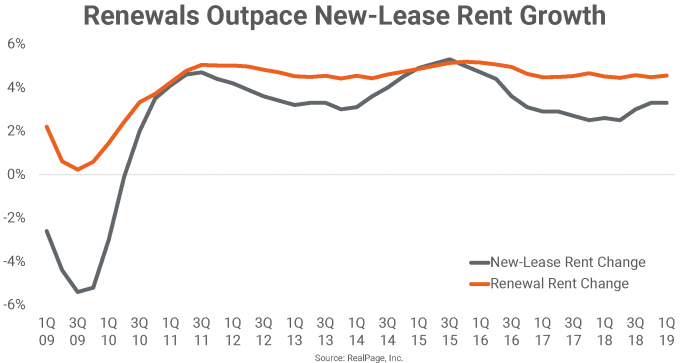How do you measure performance for a real estate business? This question may seem straightforward, but it’s not always easy to know which real estate metrics you should prioritize.
While the exact KPIs will vary from company to company, there are guidelines you can use to help identify which metrics are the most relevant for your business and goals.
We talked to industry experts to identify the top nine key performance indicators (KPIs) real estate businesses use to monitor progress in their companies. By learning from their experience, you can narrow down the best real estate metrics for your company and start collecting actionable data to keep you and your agents on track.
1. Appointment to listing conversion rate
An agent’s appointment to listing conversion rate is the percentage of appointments they make with potential sellers that turn into official listings. According to the Keller Williams Economic Model, this real estate metric is essential for determining the number of appointments your business needs to make to hit its income goals.
Appointment to listing conversion rate is a key metric for the seller side of your real estate business. But Andrew Webber, a real estate agent with Keller Williams Metro Center, advises that “[real estate metrics] need to be broken down into different sides (seller and buyer) as their numbers are often different.”
On the buyer side, a similar metric would be the conversion rate of appointments to buyer representation agreements. A representation agreement helps solidify and formalize your working relationship with the buyer, much as an official listing does with a seller.
2. Controllable operating expenses
Controllable operating expenses are costs that the landlord or property management agency can control to some degree, such as by finding a different provider or installing new equipment on the property.
Energy is an example of a controllable operating expense since you can reduce its cost by installing efficient appliances on the property. By contrast, taxes or fees for waste or snow removal are non-controllable expenses. Since, by definition, you can’t reduce non-controllable expenses, tracking and managing controllable costs is vital to maximize profits.
Controllable operating expenses are an especially important metric for commercial real estate. Since commercial agencies typically manage more rentals and industrial locations than non-commercial agencies, they often face more (and higher) ongoing costs than agencies that focus on buying and selling homes. Controllable expenses are also one of the top five KPIs tracked by clients of Yardi, a property management software company.
3. Leads generated
Leads generated is a top metric for both the seller and buyer aspects of real estate. This metric tracks the number of potential buyers or sellers that you plan to contact to schedule an appointment.
Gary Keller, founder of Keller Williams Realty, writes, “Leads are the fuel to your economic engine. And here is a truth that you must never lose sight of: You can never have enough good leads. Never.” But following up with leads is just as essential as generating them.
Monitoring how many leads you have in your pipeline can help you effectively allocate agent resources, so each lead can receive the nurturing and attention needed to translate it into an appointment and, eventually, a listing or representation agreement.
To track where your leads are coming from, break down this KPI by source. Look at how many leads are coming from your website vs. from referrals or social media. If you find one source generates more or higher-quality leads, you might focus on that source as a KPI. For example, website leads are one of the top KPIs for Jenn Cloud, marketing director at Red Key Realty.
4. Listings closed
Listings closed is the total number of closings you had during the time period you’re looking at. It’s the third metric in the often-cited Four Conversations method from Keller Williams.

Listings closed is a leading indicator of changes in profit since more closings typically mean higher income. Compare the month-over-month and year-over-year changes in the number of closings to help predict your company’s growth.
5. Listings taken
Another seller-side real estate metric is listings taken, the number of listings your agency brought in during a certain time frame, such as in a particular month or year.
Listings taken is the number one KPI for Five Doors Network Real Estate. Why? Because a high number of listings is a solid indicator of high profits. According to Michelle Jaeger, Director of Operations at Five Doors Network, listings taken is a leading indicator for the number of units closed, another key metric for increasing profit and gross commission income.

Compare the number of listings taken to your appointment to listing conversion rate to gauge the number of appointments you need to hit your listings goal.
6. Net operating income
Net operating income (NOI) measures the profitability of your income-generating properties. This is likely to be a KPI for rental-focused agencies rather than businesses specializing in home sales.
To calculate NOI, subtract operating expenses from revenue. You can track NOI for individual properties or look at NOI for your agency as a whole by taking the revenue from all income-generating properties and subtracting the total operating expenses for those properties.
NOI is a top metric for commercial real estate agencies that handle high volumes of rentals because a significant portion of their revenue comes from income-generating properties rather than one-time sales. For example, it is one of the top five real estate metrics for Yardi commercial real estate clients managing multifamily properties.
NOI may be less crucial for smaller agencies or individual agents who focus more on buying and selling properties than managing rentals since a greater bulk of their revenue comes from one-time sales rather than income-generating properties.
7. New agents joined
Monitoring internal growth metrics is just as essential for real estate businesses as tracking sales numbers. Counting the number of new agents joined each month, quarter, or year and watching how that number changes over time can help you see how quickly your business is growing.
New agents joined is one of Red Key Realty’s top five metrics.
“These metrics help us keep a pulse on our inbound agent pipeline,” comments Cloud.
8. New-lease rent growth
New-lease rent growth measures the percent increase, typically year-over-year, in rent prices for new lease agreements. This metric only looks at new agreements, not lease renewals. It is another key real estate metric for rental agencies and a top five metric for Yardi clients.
Tracking industry- and location-based benchmarks for new-lease rent growth can help you see how your rental prices change compared to others in your area.
“With the rise of big data, benchmarking has become a powerful way to assess and improve property performance,” comments Esther Bonardi, vice resident at Yardi. “Our clients compare KPIs within their own portfolios as well as benchmarking against their industry peers.”

Large commercial real estate firms will sometimes offer their own industry benchmark reports that you can use for reference, such as Yardi’s Matrix reports or RealPage Inc.’s industry analyses.
9. Pending listings
Pending listings are the number of listings you have under contract in which the buyer and seller are negotiating the final terms of the sale after agreeing on a price. Cloud lists this as one of Red Key Realty’s top five metrics for monitoring growth and agent performance.
Tracking pending listings can help you determine how to allocate agent time and resources. Since these listings are not yet closed, they still need care and attention, but they may not require as much time as a new or open listing.
Pending listings are also a leading indicator of listings closed. This is one reason the National Association of Realtors tracks pending home sales. Changes in pending sales illustrate changes you can expect to see in existing home sales a month or two down the line.
Motivate your agents with a shared real estate metrics dashboard
Once you’ve determined which real estate metrics are important for your business, keep your agents on track with a shared dashboard. Dashboards help cut through the noise of excess data by making it easy for agents to see their most important metrics at a glance.
“The dashboards act as a measuring stick for the agents to see if they are on or off track,” comments Jaeger, “and this helps them prioritise their daily actions.”
Dashboards can also serve as a leaderboard, showing agents where they stand in relation to one another and adding an element of friendly competition.
Want to see how dashboards can help your real estate business? Click here to learn more!

